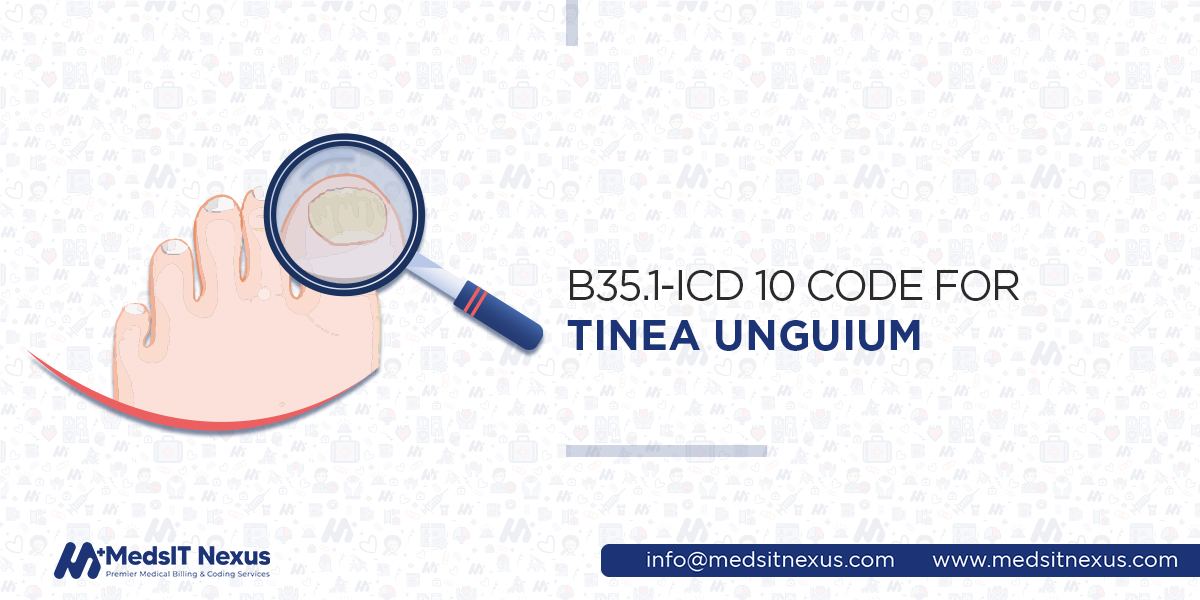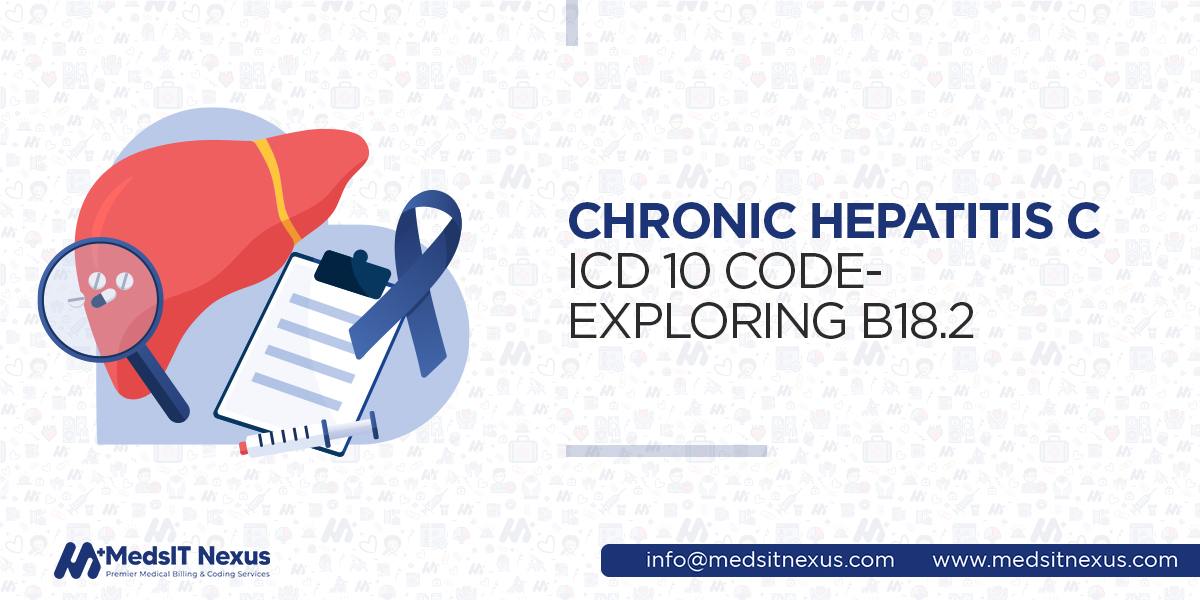b35.1-icd 10 code for tinea unguium

Medical coding may seem like an intricate web of numbers and letters, but
it serves as the cornerstone of modern healthcare. Like other diseases, accurate coding and
documentation of tinea unguium using the B35.1-ICD 10 code have significant implications for healthcare
reimbursement. When healthcare providers report this specific ICD-10 code, it enables proper disease
classification, ensuring appropriate reimbursement from insurance companies and government programs.
Failure to assign the correct code may result in delayed or reduced reimbursement, affecting the
financial health of healthcare institutions. The complexity and ever-evolving nature of medical coding
necessitate the involvement of experienced medical coding companies poised to navigate the nuances of
B35.1 and ensure precise code assignment. Therefore, healthcare practitioners outsource their B35.1
coding procedure to experienced coding and billing companies for proper reimbursement. In this regard,
MedsIT Nexus Medical Coding Services are paving an incredible pathway to successful
coding.
Let's get to know about the B35.1 code and some other codes and conditions associated with it.
2023 ICD-10-CM Diagnosis Code B35.1: Tinea unguium
Tinea unguium is a contagious infection caused by dermatophytes, fungi
that primarily thrive in warm and moist environments. It primarily affects the nails, particularly the
toenails, resulting in a range of symptoms, including discoloration, thickening, brittleness, and
crumbling of the nails. Tinea unguium is more commonly seen in toenails than in fingernails. This is
because shoes' warm and moist environment provides an ideal breeding ground for fungi. Left untreated,
tinea unguium can spread to neighboring nails and cause discomfort and pain.
With many dermatological conditions vying for recognition, the International Classification of Diseases
(ICD) system introduced B35.1 as a unique identifier for Tinea Unguium. This code, nestled within the
broader ICD 10 classification, revolutionized how healthcare providers categorize and treat fungal nail
infections. By attributing a distinct code to this condition, physicians can streamline their diagnosis
and ensure accurate tracking of epidemiological trends
Code classification
Here's the breakdown of the code classification:
Chapter: Certain infectious and parasitic diseases (A00–B99)
Section: B35-B49 - Mycoses
Category: B35 - Dermatophytosis
Code: B35.1 - Tinea unguium
The B35.1 code can be broken down as follows:
• "B" indicates that the condition is classified within the chapter on infectious and parasitic diseases
in the ICD-10 system.
• "35" refers to that chapter's specific block or category, encompassing various dermatophytoses (fungal
infections caused by dermatophytes).
• ".1" denotes the subclassification within the category, specifically identifying tinea unguium or
onychomycosis.
ICD-10 code B35.1 usage example
A 45-year-old patient visited the dermatology clinic complaining of thickened, discolored nails on both
hands. Upon examination, the dermatologist diagnosed the patient with tinea unguium. The physician
recommended a treatment plan to address the fungal infection. The plan included prescribing oral
antifungal medication, providing proper hygiene and nail care instructions, and scheduling follow-up
appointments to monitor progress. The physician assigned the ICD-10 code B35.1 to document the diagnosis
accurately in the patient's medical record, ensuring proper coding for billing and administrative
purposes.
Understanding the nuances of coding for this condition is critical to ensure proper documentation and
reimbursement. With MedsIT Nexus Medical Coding Services , we proudly introduce a
comprehensive solution:
ICD 10 Code B35.1 for tinea unguium.
Coding Guidelines for B35.1
This specific code applies to:
• Ringworm of nails
• Dermatophytosis of nail
• Dermatophytic onychia
• Onychomycosis
Other conditions associated with Tinea Unguium and their codes
While B35.1 is the primary code for tinea unguium, exploring related codes that provide further insights
into the condition is beneficial. Here are some additional ICD-10 codes associated with tinea
unguium:
Onychomycosis - (B35.1): Onychomycosis refers to a group of nail infections caused by
various fungi,
including dermatophytes, yeasts, and molds. Tinea unguium is one of the most common forms of
onychomycosis and manifests as a fungal invasion of the nail plate.
Tinea Pedis - (B35.3): Tinea pedis, also known as athlete's foot, is a fungal infection
primarily
affecting the skin between the toes. This condition is often associated with tinea unguium, as the same
fungal species can cause both infections.
Tinea Corporis - (B35.0): Tinea corporis, also known as ringworm, is a highly
contagious fungal
infection that affects the skin on various body parts. While tinea unguium mainly affects the nails, it
may sometimes coexist with tinea corporis.
Tinea Manuum - (B35.4): Tinea manuum is a fungal infection that explicitly targets the
palms of the
hands. Although it is less common than tinea unguium, the two conditions share a similar etiology and
may co-occur.
B35.6 - Tinea cruris: Commonly known as "jock itch," tinea cruris is a fungal infection
affecting the
groin and inner thigh region. Although distinct from tinea unguium, understanding this code helps
establish a comprehensive understanding of related dermatophytic infections.
L03.03 - Cellulitis of toe: Tinea unguium can sometimes lead to secondary complications
such as
cellulitis, an infection of the skin and soft tissues. This code helps capture instances where
cellulitis accompanies tinea unguium, ensuring accurate documentation and treatment planning.
MS-DRG Mapping
MS-DRG (Medicare Severity Diagnosis Related Group) is a system used by the Centers for Medicare and
Medicaid Services (CMS) in the United States to classify hospital cases based on similar clinical
characteristics and resource utilization.
The diagnosis codes are categorized into distinct groups in the MS-DRG V40.0 version.
606: Minor skin disorders with MCC
607: Minor skin disorders without MCC
Coding Tips and Best Practices
To assign the B35.1 ICD-10 code accurately, healthcare professionals must adhere to specific diagnostic
criteria. These criteria may include clinical evaluation, physical examination, and laboratory tests.
Common indicators of tinea unguium include nail discoloration, thickening, subungual debris, and
detachment of the nail plate. Dermatophyte culture or microscopic examination of nail clippings may be
performed to confirm the presence of the fungal infection.
To ensure accurate and effective coding for tinea unguium, consider the following tips:
Familiarize yourself with the ICD-10 coding manual: Stay updated with the latest
revisions, guidelines,
and conventions to ensure accurate coding.
MedsIT Nexus Medical Coding Company professionals are highly flexible and stay updated
with the latest
coding guidelines.
Pay attention to code specificity: Document the infection's exact type, size, and
severity to select the
most appropriate ICD-10 code.
Consider associated conditions: Take note of related conditions, such as cellulitis or other
dermatophytoses, which may require additional coding.
Collaborate with healthcare professionals: Engage in interdisciplinary discussions to
ensure
comprehensive documentation, accurate coding, and optimal patient care.
Navigate the Complexities of ICD 10 Code B35.1 for Tinea Unguium with MedsIT Nexus Medical Coding Services
Introducing MedsIT Nexus Medical Coding Services, your trusted partner in precision and efficiency for all your medical coding needs. Our expert team is well-versed in the intricacies of ICD-10 code classification, and we take pride in providing accurate and comprehensive solutions to streamline your medical coding processes. Our proficiency shines through when it comes to the complex realm of dermatological conditions, such as tinea unguium. With meticulous attention to detail and HIPAA-compliant services, we ensure the precise application of ICD-10 code B35.1, empowering healthcare providers with transparent and standardized documentation. We implement reliable technology and updated coding guidelines to prevent shortcomings, collect timely payments, and increase reimbursement. Experience the reliability and expertise of MedsIT Nexus Medical Coding Services, your go-to solution for optimal coding accuracy in the ever-evolving healthcare landscape.
Marshall-Russ, Technical Author -
Healthcare IT & Data Systems Analyst at MedsIT Nexus
Edit Technical documentation, workflow automation insights, and data-driven RCM improvement publications following our standard publication protocols.






